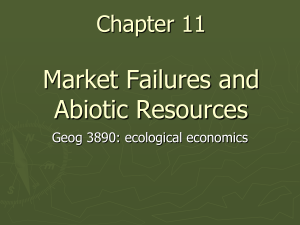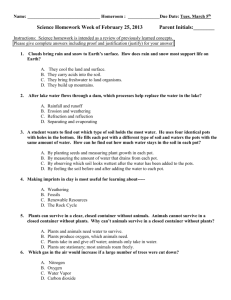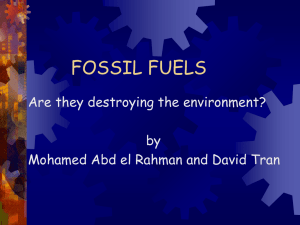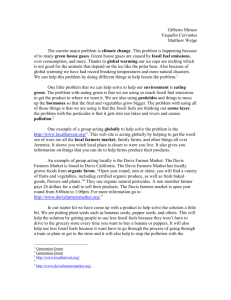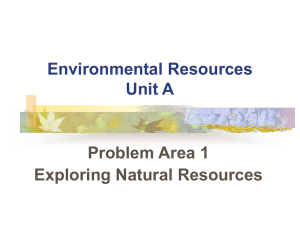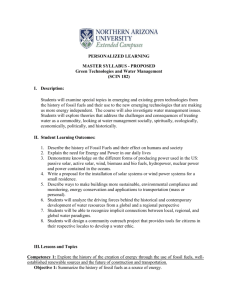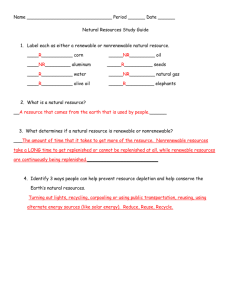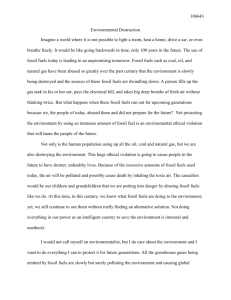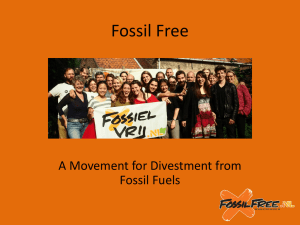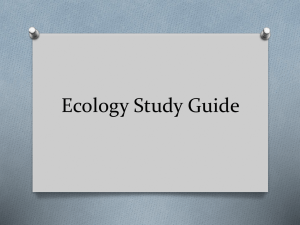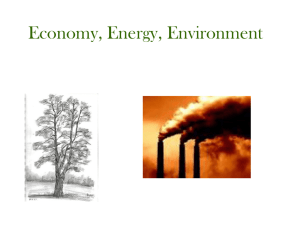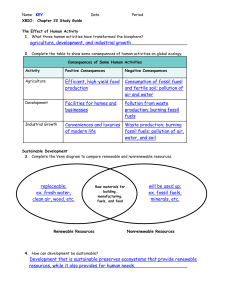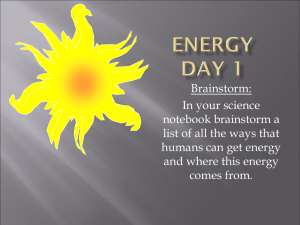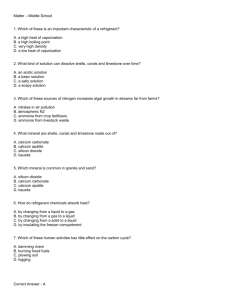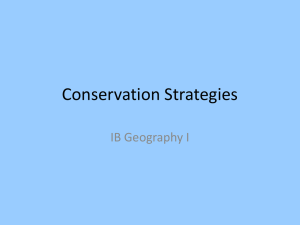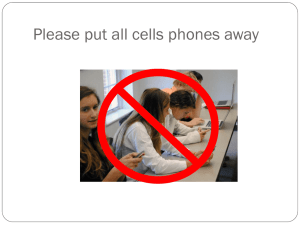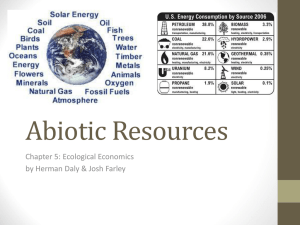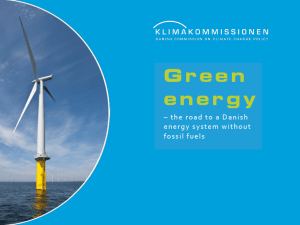Final Exam Review
advertisement
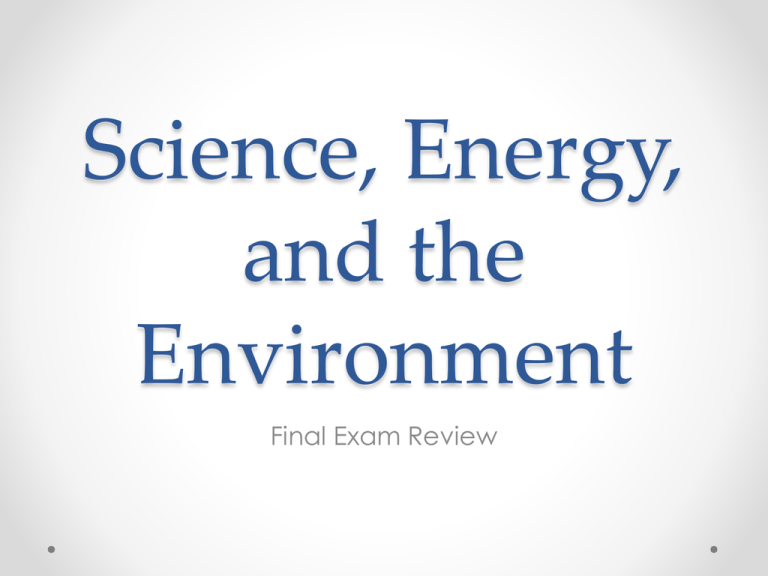
Science, Energy, and the Environment Final Exam Review Areas Energy Trash Soil • 1. All of the following are forms of indirect solar energy except: • a. wind b. flowing water • c. geothermal energy d. firewood • 2. Most commercial energy comes from • a. direct solar energy • c. extracting and burning fossil fuels • d. nuclear energy b. indirect solar energy • 3. To make decisions about energy alternatives, we need to ask: • a. What is the estimated net useful energy yield? • b. How much will it cost to develop, phase in, and use? • c. What are the potential environmental and social impacts? • d. all of these • 4. To reduce energy waste we must • a. increase energy consumption b. improve energy efficiency • c. switch from fossil fuels • d. use only solar technologies • 5. Reducing energy use and waste does all of the following except: • a. extend the length of time fossil fuels will last • b. ease international tensions • c. improve global military security • d. cause an economic recession • 6. Which of the following reasons is the worst explanation for the lack of US interest in energy efficiency? • a. Currently fossil fuels are cheap. • b. Other industrialized countries are not pursuing strong energy-efficient policies. • c. Environmental pollution costs are not reflected in the price of fossil fuels. • d. Harmful health costs are not reflected in the price of fossil fuels. • 7. Electric cars • a. are noisy • b. have been totally ignored • c. have batteries that last a car’s lifetime d. require less maintenance • 8. Renewable energy resources include all of the following except • a. the sun • b. the wind • c. nuclear power • d. Earth’s internal heat. • 9. Developing renewable energy resources would • a. save money and create jobs • b. eliminate the need for oil imports • c. increase national security • d. all of the above • 10. Cells that convert solar energy directly into electricity are called • a. electrosolar chips • b. photovoltaic cells • c. helioelectric units • d. photoelectric cells • 11. Tidal power plants • a. have high construction costs • b. run on water that flows in and out of coastal bays • c. have few suitable sites • d. all of these • 12. Wind power • a. is an unlimited source of energy at favorable sites • b. offers quick construction time • c. has a moderate to high net useful energy yield • d. all of these • 13. Wind farms • a. may be noisy • b. may interfere with migratory birds • c. require backup energy if the wind is not steady • d. all of these • 14. Biomass includes • a. wood and wood products • b. manure • c. gaseous biofuels • d. all of these • 15. A major disadvantage of using biomass energy is • a. high moisture content which lowers the net energy yield • b. higher nitrous oxide and sulfur dioxide emissions than other sources of energy • c. lack of versatility in its use and application • d. that it is not renewable. • 16. Which of the following statements about geothermal energy is false? • a. It is moderate net energy yields for large, accessible sites. • b. Easily accessible geothermal sites are rare. • c. It releases much carbon dioxide. • d. It can further degrade forests and other adjacent ecosystems. • 17. Oil is widely used because it • a. is relatively cheap • b. is easily transported • c. has a high net useful energy yield • d. all of these answers • 18. The fatal flaw of oil is that it • a. produces more carbon dioxide than any other fuel • b. produces destruction of nature through oil spills • c. can contaminate groundwater supplies • d. will be commercially depleted in the relatively near future • 19. ____ is the dirtiest fossil fuel to burn. • a. oil b. natural gas • c. coal d. wood • 20. The key advantage to using fuel cells even though some use fossil fuels is • a. that they are cheap • b. can be made commercially • c. are highly efficient • d. are still in the developmental state SOIL Vocabulary, Issues, and Agriculture • 21. Soil is composed of • a. mineral nutrients • b. air and water • c. microscopic decomposers • d. all of these answers • 22. Soil indirectly provides humans with • a. medicines • b. pure water • c. recycling services • d. all of these answers • 23. A cross-sectional view of the _____ in a soil is properly termed a soil ______. • a. horizons then profile • b. horizons then sample • c. surface litter then sample • d. surface litter then profile • 24. Humus is • a. something you put on pita crackers • b. indicative of poor soils • c. light colored or nearly white • d. partially decomposed organic matter • 25. The downward movement of water through soil is called • a. infiltration b. weathering • c. porosity d. accumulation • 26. Which of the following types of soils has the least pore space? • a. silt b. loam • c. clay d. sand • 27. Which of the following sites would be expected to have the most rapid erosion rates? • a. agricultural land b. forest • c. rangeland d. construction sites • 28. Conservation tillage reduces • a. labor costs b. amount of erosion • c. water loss from soil • d. all of these answers • 29. Contour farming involves • a. converting a steep slope into a series of terraces. • b. building a series of small dams • c. plowing at right angles to slopes • d. plowing straight down slope or straight up slope • 30. Planting crops in alternating rows of closegrowing plants • a. creates windbreaks • b. is called strip cropping • c. is called crop rotation • d. increases erosion rates • • 31. In alley cropping • a. crops are planted between hedgerows of trees • b. terraces are built to prevent swift water runoff • c. plowing runs across slopes • d. special tillers are used so the topsoil is not disturbed • 32. Which of the following is not one of the three major types of organic fertilizer? • a. green manure b. sewage sludge • c. compost d. animal manure • 33. The term under nutrition refers to people who • a. eat less than the basic minimum of calories per day • b. eat balanced meals • c. eat too much food • d. suffer from poor food quality • 34. The term malnutrition refers to people who • a. eat less than the basic minimum of calories per day • b. eat balanced meals • c. eat too much food • d. suffer from not eating the needed balance of nutrition • 35. A pest is any organism that • a. spreads disease • b. interferes with human activity • c. competes with humans • d. all of these • 36. Pesticides kill • a. rodents b. weeds • c. insects d. all of these • • 37. According to pesticide proponents, pesticides • a. work faster than alternate controls • b. increase profit for farmers • c. saves money and lives • d. all of these • 38. Pesticide applications have threatened • a. honeybee colonies • b. predatory birds • c. fish-eating birds • d. all of these • 39. Sustainable agriculture is characterized by a major use of • a. massive irrigation projects • b. fossil fuels • c. pesticides • d. organic fertilizers • 40. An individual can support the concept of sustainable agriculture by • a. eating lower on the food chain • b. developing a home garden • c. using biological pest control • d. all of these answers • Waste and Recycling 3R’s, management, and issues • 41. Which of the following questions is least likely to be asked by an environmentalist? • a. Where do we put all of this waste? • b. What strategies can turn the waste of one industry into the resources for another? • c. What policies encourage products that last? • d. How can industries reduce the formation of toxic by-products? • 42. The top priority in pollution prevention approach to solid waste would be • a. recycling b. reusing • c. reducing d. burning • 43. A low-waste approach • a. eliminates unnecessary packaging b. makes a products last longer • c. uses less material • d. all of these answers • • • • • 44. Compost is most completely described as a. manure b. landfill by-products c. pure garbage d. soil conditioner & organic fertilizer • 45. Which of the following substances can be recovered from solid waste? a. metals b. plastics • c. paper d. all of these • 46. Consumers of recycled products are most effective when they maximize the amount of ______ waste in the products. • a. pre-producer b. post-producer • c. pre-consumer d. post-consumer • 47. Environmentalists would most object to plastics used in • a. lunch boxes b. shampoo bottles • c. packaging d. storage containers • 48. Obstacles to recycling in the US include • a. environmental cost • b. inconvenience • c. tax breaks • d. all of these • 49. Secondary recycling means • a. materials are remade into the same product (paper to paper) • b. materials are remade into different products (jeans to carpet) • c. materials are recycled before they are used by a consumer • d. all of the above • 50. The study of environmental science includes • a. anthrosphere • b. biosphere • c. hydrosphere • d. all of the spheres

